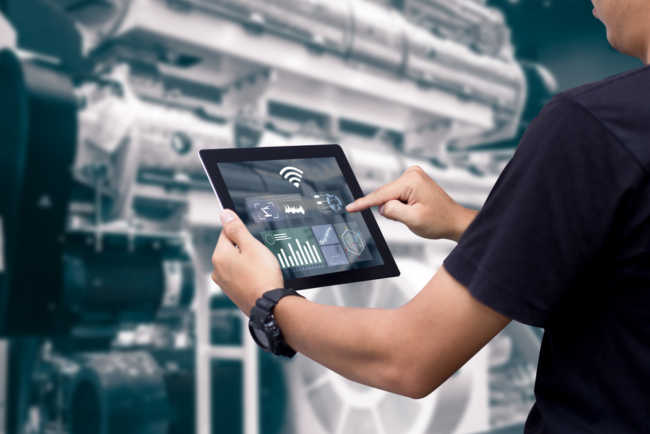5 Challenges of Remote Industrial Operations. Solved with IIoT
High logistics costs, the lack of skilled labor, employee conflicts, and the complexity of the global supply chain – these and other factors encourage manufacturers to resort to distributed production. Outsourcing a part of the manufacturing operations or building a manufacturing facility closer to a regional sales market may seem a perfect way to lower operational costs and increase production efficiency.
However, together with the promised benefits comes a critical challenge – the loss of visibility and control over the remote manufacturing processes. Monitoring the compliance with manufacturing and production standards, ensuring employee safety, and product quality control all become issues.
To address them, enterprises can turn to IIoT.
In a Nutshell: How Does IIoT Work?
Applied in the manufacturing ecosystems, IIoT provides visibility into the manufacturing and supply chain operations, so that enterprise managers know exactly what is happening on a remote facility’s shop floor and along the supply chain. They get access to accurate information about critical production process parameters (e.g., equipment utilization and condition, available inventory, product quality, and more), as well as health-related parameters and physical activity of employees.
This information becomes available due to sensors and RFID tags, which are attached to pieces of equipment and inventory items or are worn by the workers. Depending on an IIoT solution’s purpose, sensors gather data on a wide range of parameters, e.g., temperature, pressure, vibration frequency. Once collected, the sensor data is relayed over to the cloud software, where it is stored and analyzed to provide the insights about remote facility’s production efficiency, inventory levels, product quality, etc. The insights obtained with the analysis get visualized and displayed to the enterprise managers via web or mobile user applications.
Key Challenges of Remote Operations and Ways to Address Them
IIoT helps to address key industry 4.0 challenges enterprises face while dealing with remote and outsourced operations, namely, their limited abilities to:
- Monitor remote facility performance.
- Ensure equipment reliability.
- Monitor the quality of finished products.
- Maintain optimal inventory levels.
- Ensure employee safety.
Each of these challenges can be addressed with a particular IIoT application. Let’s have a closer look.
Monitoring the efficiency of remote and outsourced operations
To monitor how efficient remote and outsourced manufacturing operations are, enterprises can leverage IIoT-driven solutions for machine utilization monitoring. These solutions allow gaining second-by-second visibility into equipment availability and performance metrics (e.g., throughput, capacity utilization, etc.) and are reported to increase manufacturing productivity by up to 25%.
Machine utilization monitoring starts with fetching relevant data about machine operating parameters via a machine’s serial or Ethernet port or from a sensor attached to a machine’s control panel (the sensor in such case tracks digital signal lines from a machine’s PLC). Once analyzed and visualized, the data about machine operating parameters provides manufacturers with informative insights about machine utilization KPIs. A manager at a headquarters can access the data from a remote facility’s shop floor in near real-time and view the data about machines’ statuses, uptime, downtime, the number and the duration of cycles, and other metrics.
Ensuring equipment reliability
IoT-driven predictive maintenance solutions ensure that equipment at a remote manufacturing facility is reliable and the production process does not stop due to machinery failures. Along with that, it optimizes equipment maintenance efforts and eliminates the need to keep a local maintenance team.
A predictive maintenance solution analyzes the data about a range of parameters influencing machine condition, e.g., temperature, vibration frequency. By combining machine health data with the context (equipment usage history, maintenance data, etc.) and analyzing the combined data set with machine learning algorithms, a predictive maintenance solution identifies whether a particular piece of equipment is likely to fail, predicts the time of a potential failure, and recommends an appropriate mitigating action and an optimal date for a checkup.
Monitoring the quality of finished products
Manufacturers dealing with remote or outsourced operations can have hard times establishing efficient practices for product quality control. Often, they uncover quality issues when a product fails during testing or when a customer makes a recall.
IIoT helps to discover quality issues as early as possible. Moreover, due to predictions obtained with the analysis of historical data about quality deviations, IIoT can help to avoid quality losses altogether. The managers at a headquarters get access to accurate data about the quality of goods in production and can view product quality dynamics for any period of time to develop best practices for improving product quality.
To enable that, the analytics component of IIoT analyzes historical data about past quality issues, machine health and ambient parameters, as well as machine operating parameters to reveal those parameter combinations that are likely to lead to quality losses. Taking in real-time machine sensor data and analyzing it against the detected patterns, an IIoT solution identifies if current equipment condition and operational parameters are likely to deter product quality, and notifies an operator.
Maintaining optimal inventory levels
IoT-driven inventory management solutions help to address two critical challenges: ensuring that a remote facility has enough inventory volumes to keep the operations going and controlling the adherence to the production schedules by tracking work-in-progress inventory. Carrying out these tasks is hardly possible without the data about currently available inventory volumes and the location of inventory items. Coupled with RFID, IoT provides access to this data.
To enable inventory tracking, inventory items are labeled with RFID tags and a remote manufacturing facility is equipped with RFID readers. The readers scan the tags, determine inventory items the tags are correlated with, and identify their locations and quantity. Recording the locations of inventory items over time, IIoT tracks the movements of the items on a shop floor and at local storage facilities. With this data at hand, inventory specialists make data-driven decisions to optimize inventory management and reduce lead times.
Ensuring employee safety
To ensure that a remote facility is compliant with safety standards and prevent work-related accidents, enterprises can leverage IoT-enabled solutions for monitoring employee safety. These solutions are of particular relevance for the industries, where employees work in hazardous environments, e.g., oil and gas, mining.
IIoT enables constant monitoring of employee location and health-related parameters, such as heart rate, skin temperature, galvanic skin response, etc. By analyzing the data from sensors worn by employees, the analytics module of IoT detects unusual behavior patterns and timely reports a safety threat to prevent employees from falling, overheating, etc.
For instance, if a safety monitoring solution detects that an employee has high skin temperature, a raised heart rate, and shows no movement for several seconds, the solution concludes that an employee is suffering from overheating and notifies a medical worker or an employee’s manager.
Why Go for IIoT?
Applied for monitoring remote and outsourced operations, IIoT ensures:
- Instant access to information
Traditional methods of collecting and analyzing data (for instance, spreadsheet-based ones) require much time and human effort. The data from a remote facility is collected, aggregated, and analyzed manually, which means it becomes available to the enterprise management with significant delays. With IoT, enterprises get access to accurate data and the insights obtained with the analysis of this data in near real-time.
- Precise visibility
Manually gathered data is unlikely to contain every meaningful data record. This means that important insights can be missing. IoT and RFID, on the other hand, allow capturing and storing detailed data about every minor change of object location, property, condition, etc., which enables precise visibility and improves analytics accuracy.
- Detailed analytics
IoT allows manufacturers to generate custom reports about every relevant KPI. Besides general insights about a remote facility’s uptime, safety conditions, and the total number of produced parts, IIoT allows to drill down each KPI, view the dynamics on a timeline, and identify root causes behind the reduction in the effectiveness.
The Challenges of Applying IoT
Although IIoT-driven applications offer numerous benefits, the deployment of these solutions can be challenging. Key concerns include:
- Substantial investment needs
Rolling out an IoT solution presupposes several areas of investments. Along with obvious investments in IoT devices, connectivity, and cloud services, IIoT involves spending on administrative labor, technical support, and more.
- Connecting legacy equipment
Many manufacturing facilities still use machines that are 20+ years old. Such machines were not designed to connect to the Internet. Making such machines a part of an IIoT solution is not trivial and requires considerable time and effort.
To Recap
IIoT provides enterprises with real-time visibility into the remote and outsourced operations. This allows enterprises to make data-driven decisions and develop best practices to increase the productivity of remote operations and lower operational costs. However, rolling out an IIoT solution is not fast and easy. To reap benefits, an enterprise should consider possible limitations and work out optimal ways to address them.
 Boris Shiklo, CTO at ScienceSoft, is responsible for the company’s long-term technological vision and innovation strategies. Under his supervision, the company’s development team has successfully fulfilled complex projects of over 80,000 man-hours in Healthcare, Banking & Finance, Retail, Telecommunications, Public Sector and other domains. Boris Shiklo has a solid background in IT consulting, software development, project management and strategic planning.
Boris Shiklo, CTO at ScienceSoft, is responsible for the company’s long-term technological vision and innovation strategies. Under his supervision, the company’s development team has successfully fulfilled complex projects of over 80,000 man-hours in Healthcare, Banking & Finance, Retail, Telecommunications, Public Sector and other domains. Boris Shiklo has a solid background in IT consulting, software development, project management and strategic planning.
